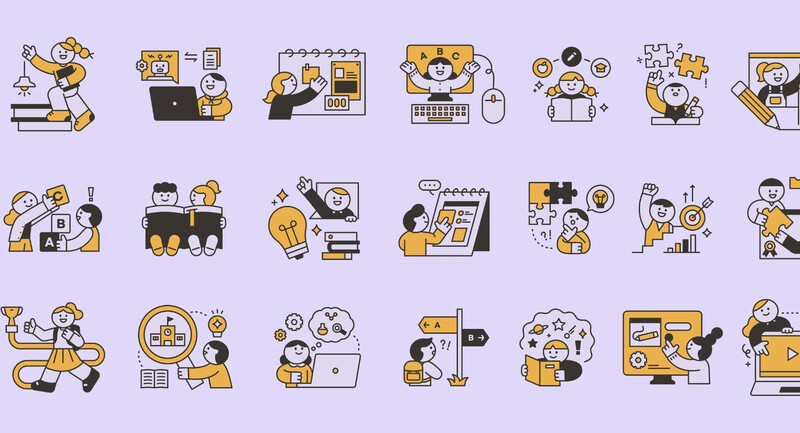It has taken me most of my life to learn how to write well. My grandfather used to tell me that I came from a family of writers, yet I struggled as a writer in school. My teachers assigned a topic and supplied a due date, but that was about all. The actual writing was up to me. I would write at home alone, and then my mom or my grandfather would take their red pens to my paper. Their edits and comments taught me valuable lessons about writing. I realized that I tended to repeat words, split infinitives, and use ten words when five would do. These editing sessions revealed the hidden secrets of writing.
Unlike my experience, many students do not have confident writers at home ready to edit their work. Writing instruction and feedback must come from the teacher if students are to develop as writers. However, traditional approaches to teaching do not make this easy. When one teacher is guiding a class of 30-plus students through a one-size-fits-all lesson, there isn't time to provide individualized instruction and regular feedback. As a result, writing doesn't happen in the classroom—it happens at home, alone, with little to no support if students get stuck.
For teachers to support students with a range of abilities in writing, we must embrace new approaches to teaching that use technology strategically. Blended learning models, like whole group rotation, the station rotation model, and the flipped classroom, can help teachers give students more individual support.
The Whole Group Rotation
Whole group rotation, as I argued in my last book, Blended Learning in Action (Corwin, 2016), is a modern twist on lab rotation. It allows teachers to rotate an entire class through a series of online and offline activities. The rise in 1:1 laptop initiatives and the increasing availability of mobile Chromebook carts allow teachers to blend whole group face-to-face instruction with independent, self-paced work online without leaving the classroom. During the sections of the lesson when students are working individually or collaboratively online, teachers can work with individual students or small groups of students to develop specific writing skills. The online work also creates opportunities for students to write in class instead of taking complex writing assignments home where they may not have support.
The Station Rotation Model
In the station rotation model, students rotate through a series of online and offline stations. This model is ideal for classrooms with limited technology. Teachers can design one online station or multiple, depending on their technology access. One of my stations is always a teacher-led station, which I affectionately call "Tucker Time." At this station, I provide individualized instruction, model a process, or provide real-time feedback as students write.
At times, an entire 90-minute station rotation lesson will focus on a formal piece of writing. In one offline station, students "dig for evidence," winnowing through their annotations and re-reading sections of the book to find textual evidence. In an online station, they might watch a video about how to begin their essay with a hook strategy or how to cite their textual evidence. In another station, they continue writing—online or offline, depending on our access to technology. Finally, my teacher-led station is spent providing real-time edits and feedback in my students' Google Documents as they write.
This model creates opportunities for me to work directly with my students and have conversations about what is working in their writing and where they need to focus their time to rework it. Having a real-time feedback station has also freed me from taking their writing home to edit, which is a great incentive for me to prioritize the writing process in class.
The Flipped Classroom Model
Many teachers use the class time they have to explain the "how" of writing via direct instruction. Unfortunately, whole-group instruction is rarely effective. Classrooms are composed of many different learners with varied skill sets and language abilities. Instead of lecturing about writing instruction, I encourage teachers to record short video tutorials that introduce individual parts of the writing process: how to write a thesis statement, how to format a body paragraph, and how to introduce quotes. These videos can not only replace the whole-group instruction, thus freeing up teacher's time, but they also have clear benefits compared to a live explanation. Students can self-pace through the explanations, pausing or rewinding a video. The videos are available online any time a student needs to access that explanation. An online video playlist is also easy to share with new transfers into the class or parents who want to support their children at home.
Teachers can record short video tutorials on Chromebooks or laptops using Screencastify—a free Chrome Extension—and share the videos directly from their Google Drive or upload them to YouTube to create a writing playlist.
Move Writing into the Classroom
When class time focuses on explaining the mechanics of writing, as opposed to the actual writing itself, teachers lose the ability to provide feedback and individual attention to their student writers. It shouldn't surprise educators that many students don't complete written assignments in this traditional model.
Just as most teachers don't enjoy taking stacks of grading home, students don't enjoy spending hours of their time outside of school on writing assignments. Moving this work into the classroom translates into a higher percentage of students who complete the assigned writing. In my class, 95 percent of my students complete a draft of their writing assignments. This wasn't always the case. It wasn't until I embraced blended learning models and learned how to leverage technology that I was able to prioritize the process and support my students as they developed into writers.







